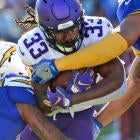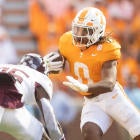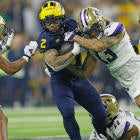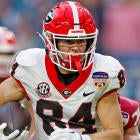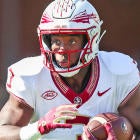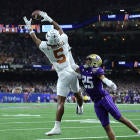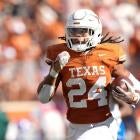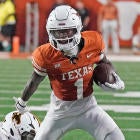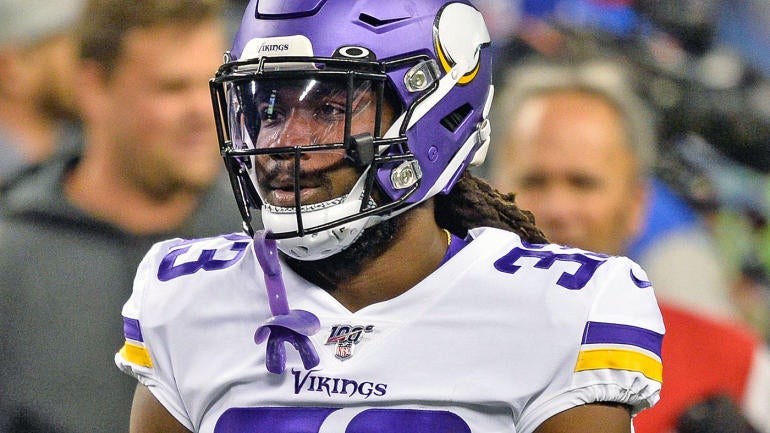
I've long struggled with how to accurately utilize projections when drafting my Fantasy football teams, because they are a snapshot of just one potential outcome for a player. That outcome might be the most likely one — that's what projections strive to articulate — but because it's a single possibility, a lot of context is lost.
I explained in my tight end range of outcomes article a little more about how this can mask fringe outcomes. I suggest giving the introduction to that piece a read for more information, but the gist is that these fringe outcomes, which are often lost in a projection of the most likely scenario, are the most important elements for Fantasy Football. Peripheral outcomes are where league-winners are made, and league-winning upside outcomes have a disproportionate impact on who wins your league.
So as we go through our position preview weeks here at CBS Fantasy, I'm emphasizing players at key decision points in drafts where the upside and downside outcomes should be weighed. We started with the tight end and quarterback positions, and today we're answering questions like how to decide between Ezekiel Elliott, Alvin Kamara and Dalvin Cook in the early part of the first round, which of the next tier of backs that stretches through Round 2 has league-winning upside, and how to view late round backs.
I'll be using PPR scoring, and for me upside at the running back position in PPR is closely tied to receiving potential, something I covered in a recent piece on High-Value Touches (HVT).
The charts you'll see are subjective — they are inexact visuals I've created where I'm projecting a range of potential outcomes. Many range of outcomes tools are built on player comps or other historical data, but I'm trying to forecast the future here. Your results will and should vary, maybe on my whole opinion of a player, or maybe just on the shape of their curve i.e. their projected range of upside or downside. We've also published tiered versions of my baseline running back projections that you can review for context.
The way to read these curves is the probability under the curve at any given point is the probability of that outcome occurring. The higher the curve, the more likely I think that positional finish is in PPR scoring. Also, consider these charts mostly healthy projections, as they are an attempt to analyze the statistical production for each player.
Kamara vs. Zeke vs. Dalvin
There's a pretty strong consensus on Christian McCaffrey first and Saquon Barkley second at the running back position, and I happen to think those two valuations are correct. But RB3 is the first major decision point, and I have Alvin Kamara there, largely due to his receiving upside.
Kamara has actually run substantially fewer routes than Ezekiel Elliott over the past two seasons, but each year he's been targeted on at least 27.5% of his routes, an elite rate of Targets Per Route Run (TPRR). Elliott's TPRR, meanwhile, was strong at 22.1% in his one big receiving season in 2018, but has otherwise been sub-15% in each of the other three seasons of his career.
Cook is the third name here, and his TPRR has never been lower than 19.7% in a season and was 23% in 2019. A Twitter follower asked me several weeks ago what the major difference was between Cook and Derrick Henry, and it's a fair question, but the answer for me is the perhaps underrated receiving potential Cook retains, which is a big reason Cook was comfortably the RB2 in PPR points per game last year, ahead of Henry's elite rushing season.
All three of Kamara, Elliott and Cook play in offenses where they can rack up green zone touches and reach double-digit touchdowns, though Elliott and Cook have access to much higher rush totals than Kamara. But while Kamara is still searching for his first 200-carry season and his touchdowns cratered in 2019, his three-year profile tells the story of a back with frankly more potential upside than what he's done. He'll need to put together a 16-game season getting the lion's share of the touches, but that's something his early 2019 usage, before his high ankle sprain, suggested could be in the offing for 2020.
After that, I'm leaning Elliott for his reasonably stable floor. Elliott's receiving role is very solid, if unspectacular, and it's hard to imagine a perfect world where all the league's backs stay healthy and Elliott doesn't still finish as a top-10 guy. Of course, the same is true for Cook, whose upside is likely higher than Elliott's, though Cook also carries a bit more team-related downside should Minnesota take a significant step back.
What to make of Clyde Edwards-Helaire?
Note that the scale has changed such that it now stretches to RB24.
At first glance, this curve probably makes Clyde Edwards-Helaire look like a bad pick. But one reality I probably should have emphasized before now is visualizing things this way is not to scale. The impact of elite upside, and the points it requires to have legitimate RB1 or RB2 upside, are both very high. Meanwhile, the difference between, say, an RB10 finish and an RB20 finish isn't ideal, but is far less impactful that the visual probably lets on.
To me, the argument against Henry would be that his 2019 output was the ceiling with a player of his profile. Through the first nine games, he eclipsed 18 PPR points just once, and that's a number he'd likely need to average to be a top-five back. Of course, he went on a late-season tear for the second straight year. But from Week 10 through the Titans playoff run, Henry averaged 24.7 carries per game, a 395-carry pace over a full 16-game season. On that massive workload, he also averaged more than 6 yards per carry.
If you're drafting Henry at his ADP in PPR, you're drafting him for what he did in the second half, not the first, and you're hoping he can stretch that to cover an even larger part of the season. But that's precisely what's so difficult to imagine — Henry is clearly a different type of back than nearly anyone else, but repeating a stretch even close to what he posted in 2019 will be challenging on multiple fronts, let alone building off it and hitting an even higher ceiling. Two challenges include the loss of tackle Jack Conklin and the likelihood Tennessee won't remain as efficient as an offense overall (which of course goes hand in hand with what Henry's able to do).
Henry needs that rushing efficiency because of his very limited receiving role, as he's never caught more than 20 passes in a season. Other backs in the first couple rounds whose curves fit a similar shape include Nick Chubb, Josh Jacobs, and potentially Joe Mixon. Aaron Jones also arguably fits, particularly the part where his 2019 output might be close to his ceiling after Green Bay invested in a bulldozing early-down backup in A.J. Dillon and already have shown a propensity to allow Jamaal Williams to cut into Jones' passing downs work.
Edwards-Helaire, meanwhile, has a much wider range, both in terms of upside and downside. I prefer this type of back, but I do have to acknowledge there is risk. His overall touch floor is not particularly high — would it be that surprising if the Chiefs went with DeAndre Washington and even worked in guys with experience in the offense like Darrel Williams and Darwin Thompson in a way that limited Edwards-Helaire's touches, particularly early in the season? While players like Henry, Chubb and Jacobs have floors buoyed by high carry volumes, Edwards-Helaire has little guaranteed to him.
And yet, his upside is massive, particularly as it relates to the all-important High-Value Touches. And I think that upside is strong enough in the Chiefs offense, with Damien Williams optimg out, that he slides in just above Miles Sanders in my personal ranks at RB6. Edwards-Helaire's upside case is something akin to how Kamara burst onto the scene with double-digit touchdowns in his first two seasons plus 81 receptions in each. That would be PPR gold.
Sanders is a back with a similarly shaped curve to Edwards-Helaire, but with lower downside risk and I'd argue a slightly lower ceiling as well. But the similarity lies in his receiving role. In year one, Sanders caught multiple passes in 15 of 17 games, playoffs included, which was particularly notable given his carries were briefly limited in October after some poor early-season play. Should the Eagles stay true to what they've been telling us that he will lead the backfield, Sanders can reach statistical heights a guy like Henry probably can't.
Other backs in this range include Kenyan Drake and Austin Ekeler, and I would plot both of their curves more like Edwards-Helaire's than Henry's due to potentially strong receiving roles. I'm higher on Drake because Ekeler is someone who I have some team-level concerns about.
Jonathan Taylor vs. the vets
Note that the scale has changed such that it now stretches to RB36.
This is the area of drafts that I've written about before as an area where I avoid running backs. And this year in particular, there are a ton of backs with shaky ranges of outcomes that are boosted by median projections. I very rarely take backs in this range in my own drafts, and in particular I avoid players like Todd Gurley.
I will readily acknowledge the opportunity is there for Gurley, and the offense he's in could make him a beast. In fact, he would be my favorite of a set of backs including Melvin Gordon, Leonard Fournette, James Conner, Le'Veon Bell, David Johnson, and Chris Carson, all of whom have recent NFC ADPs in the third or fourth round. Gurley's curve is meant to represent many of these types of backs, and the point it should elicit is while the highest and most likely outcome drives his ADP, his downside and upside from that point are asymmetrical, with far more downside risk.
Each of the backs in this group is an example of needing to at least in part pay for past production when a player's situation has changed, which might be the surest sign of overvaluation at RB. Each is at least 25 years old with some type of injury history behind them, and younger backs behind them on the roster. There are examples of players like DeMarco Murray rebounding during his one big year with the Titans, but that came after a bust year with the Eagles, and Murray was out of the league two years later. Fantasy Football history is unfortunately littered with great backs who couldn't reverse the decline phase, with a few of these impressive rebounds sprinkled in, and even the ones who carry some legitimate upside are way more tantalizing during draft season than they should be if an honest evaluation of their risk is done.
Meanwhile, if I do take a back in this range, it's likely to be someone like Taylor. In doing that Running Back Dead Zone research last year, what I found was a small number of backs who emerged from these middle rounds who had legitimate league-winning upside. But of those, almost all were young players breaking out for the first time. Rookie year Doug Martin, rookie year Kareem Hunt (whose ADP shifted significantly), second-year Ray Rice and second-year Arian Foster were four of the clearest hits. Just outside the Dead Zone, with a little later ADPs, there were a few more young breakouts like second-year Devonta Freeman, third-year Darren McFadden (at 23 years old after being a young rookie), rookie-year Alvin Kamara, and second-year Jamaal Charles. I've just listed eight of only 12 total backs who fit my "league-winning" benchmarks with an ADP from Round 4 through Round 13 over a 10-year evaluation period. There were 56 total backs in that "league-winning" group, so it wasn't super restrictive — 5.6 backs per year being "league winners" doesn't even make a lot of sense since only one team can win a Fantasy league.
At any rate, there were only four older or previously established backs who were truly elite across all those rounds and all those years. Historically, if a back who has already been very productive is going to continue to be elite, he better still have enough trust from the Fantasy Football community to have an ADP in the top three rounds, and even the third round is a little murky (there were only five more backs with third-round ADPs in that league-winning cohort, and two were early-career Le'Veon Bell and early-career LeSean McCoy, meaning three more veterans across 10 years).
Now, to be fair, we saw Derrick Henry crush from this range in 2019, so we can add him to the list. And there have been plenty of backs who have been just fine, but not league winners. For me, a third- or fourth-round pick is not worth a small ADP win if there's considerable risk attached to it, but I do understand that many at this point are buying into what appear to be guaranteed touches not looking for an elite RB season, but just a solid RB2.
Still, my expectation remains that the wide receivers in this range will be much better picks overall, with better upside and also less downside risk, which comes attached to all backs given how opportunity-dependent the RB position is. If there is indeed someone who comes from this range to help define the 2020 Fantasy season, it will likely be someone like Taylor, whose upside case is enticing. Taylor might come in lower than Gurley in a projection — which would be reflected by the highest points in their respective curves — but even before seriously considering injury, Taylor's curve features more paths to the top five at the position. And that's what's worth targeting.
Kareem Hunt vs. J.K. Dobbins vs. Tarik Cohen
We'll finish up with one of the biggest reasons I wanted to do this exercise across any position — to discuss the differences in late-round running back profiles. I'm hitting on a lot of rookies, but J.K. Dobbins makes sense as our template for a certain type of high-upside handcuff. His immediate path to big touches isn't clear, but should an injury occur in front of him, he could vault into a phenomenal situation. Darrynton Evans, one of my favorite sleepers, could be added to this list, as could names like Tony Pollard, Alexander Mattison, and several other backs that have long been referred to as handcuffs and don't have other clear standalone value. Judging these players based on projected end of season finish, as I am doing in the curve above, almost doesn't make sense — the presence of potential weekly upside is what is enticing.
Then there are the pass-catching specialists like Tarik Cohen. These backs don't have the same outright upside, though they will typically project to beat ADP. I do think Cohen is in a solid spot to have a big season, and not much is made of how strong his receiving role was last year on a team that threw to the position plenty. Other backs in this group include James White and Nyheim Hines, but if I had to pick one who could have a top-10 PPR season in the mold of Darren Sproles, Danny Woodhead, or White himself, it would be Cohen.
Lastly, there are the backs with standalone value plus three-down upside should an injury occur. These can be difficult to identify, but they are the most well-rounded backup RBs you can target. Hunt is an obvious candidate whose ADP reflects it, but there are a lot to like this year that could arguably include Zack Moss, Boston Scott, Darrell Henderson, Chase Edmonds, and DeAndre Washington.
Understanding these different profiles is key to building a strong RB corps in the later rounds. You want plenty of names from the Hunt cohort, because you can likely plug them into your lineup if need be. The Dobbins cohort might not be trustable unless things break right, so a bench full of them might leave you thin should you need that RB depth. And the Cohen cohort doesn't have quite the same upside — though perhaps more upside than we sometimes assume because of their high rate of High-Value Touches — so I tend to limit myself to just one as a safety valve I know I can play.
A strong RB bench for a team that only took a couple of backs through the first seven or eight rounds might have one of the pass-catching specialists, one or two true handcuffs, and otherwise be as heavy as possible on backs who have established roles and also have upside.












